Ways to use cream and fruit confectionery fillings
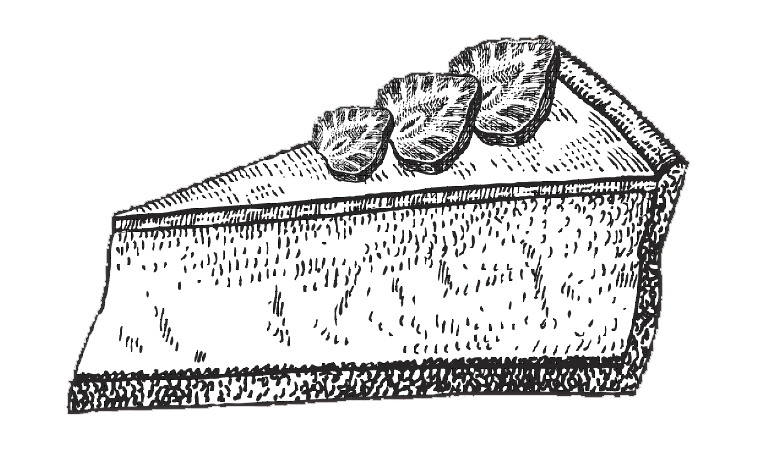
Ready-to-use fillings have become an indispensable component of pastry shops. They are convenient, have multiple applications and a variety of flavors and textures to choose from. They diversify the product and make it more attractive. To create confectionery fillings, high quality ingredients are used, which ensures the optimal level of producer and customer satisfaction. The fillings may be used directly or modified by mixing with various ingredients. In this article, based on the Lauretta product line, we will present the characteristics of the fillings and an array of possible ways to use them.
Confectionery filling properties
Lauretta fillings are thermostable – they don't change their characteristics when baked or frozen. This means that they maintain their volume and shape. No matter if the filling is inside of the baked good or on top of it, the texture, flavor and aroma stay the same.
The fillings may be used on a ready-to-use, frozen product, using the flash freezing method and then baked-off. The texture allows for manual and automatic dosing. Mechanical processing doesn't influence the properties of the fillings.
Laurreta enables our customers to prepare high and repeatable quality bakery goods. Repeatability is important, as it guarantees that the fillings always taste, look and bake the same way. Ready-to-use fillings are convenient and easy to use, and their usage saves time without lowering the quality. Long shelf-life is another advantage.
Technology behind use of confectionery fillings
Lauretta produces cream and fruit (smooth or with fruit pieces) fillings. Depending on your needs, you can mix them with cream, butter, chocolate, gelatine, jelly, cottage cheese, cream cheese, mascarpone cheese, yogurt, etc. This way, they create fluffy, colorful and diverse creams used in cakes, pies and pastries. However, there are many more ways to use confectionery fillings.
You may use Lauretta directly to fill the baked goods or spread it on them. The filling is then used in products intended for baking or already baked.
The most popular bakery goods are: yeast cake, danish pastry, puff pastry and short cake. They are used to make pastries, cakes, tarts, donuts, yeast cakes, and blueberry buns, which can be filled or layered with a smooth fruit filling. The same goes for various buns, pies, croissants, muffins, cones, triangles, crescent rolls, braided breads, loafs and gingerbread.
The fillings with fruit pieces, on the other hand, work well in recipes where fruit in gel is used: for layering cakes, log cakes and desserts. All of the fillings may be used in waffles, pancakes or even in omelettes, too.
Example recipes:
- Chocolate Muffins with Egg Liqueur Cream
- Yeast Buns with Peach Filling
- Crumb Buns with Strawberries
- Classic Doughnut
- Apple Cinnamon Croissants
- Banoffee Tartlets
- Tartlets with Strawberries and Rum&Chocolate Cream
- Meringue with Lemon Filling, Mascarpone and Strawberries
- Champagne and Strawberry Cake
- French Tart with Vanilla Cream
- Coconut Cheesecake with Blueberries
- Poppyseed Cake with Coffee-Flavoured Filling and Blackcurrant
- Traditional Gingerbread with Orange Pectin Jelly
- Cream and Blueberry Roulade
- Christmas Poppy seed Cheesecake
- Panna Cotta Tart with Blueberry Filling
- Gingerbread Roll
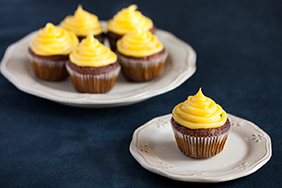
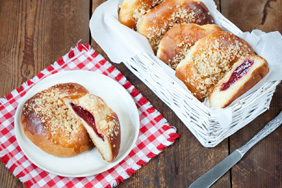
The fillings work well combined with cream and other components. by doing that, you receive creams perfect for filling and layering of cakes.
Any fruit or cream filling of any flavor can be used to make such creams. Products we recommend to combine the fillings with:
Cream
The product formed from the combination of cream and filling is an excellent, delicate mixture ideal for cream rolls, napoleons, karpatka, eclairs, layered cakes, etc. This type of cream is stable and properly aerated, which means it gains volume and lightness. Its more delicate in flavor compared to each of its components separately: less sweet than the filling and lighter than the cream on its own. It is a great alternative for powdered cream mixes. It is also a safe product due to the lack of water use – in practice, you rarely boil the water added to powdered cream. When it comes to the costs: they are comparable to using powdered cream mix, especially if you use plant-based cream.
You may use both animal-based cream (you have to stabilize it with gelatine/ about 20 g per liter of ready product) and plant-based cream – there is no need to use gelatine in this case. It is worth experimenting with the combination of the two types of cream. The addition of plant-based cream makes the product more aerated. In our "ideal product" the cream base is created by combining 70% of sweet plant-based cream and 30% of animal-based 36% cream (or 30%), without adding any sweeteners.
Whip the cream and combine with a filling of any flavor. The recommended amount of the fillings is 20-50 g per 100 g of cream but you may also adjust these proportions. The more filling, the stronger the flavor, e.g. vanilla. The ready product will be the lightest and the most aerated with a smaller addition of the filling. If you later combine the cream with the fillings with fruit pieces, you may also add some sugar (5-10% of cream weight).
It is worth experimenting with different proportions and checking them in the final product. Using Lauretta's wide range of filling flavors, you can create creams with a variety of tastes.
We recommend trying other additions to the cream mixture, such as cream cheese, mascarpone or white chocolate. If you need to use gelatine, add it in a dissolved form at the very end, after combining the whipped cream with the fillings and stir gently.
Mascarpone cheese
By adding mascarpone to the fillings, you will get a stable and fatty cream. You can make a flavored cream with this type of cheese by mixing mascarpone and the filling (2:1 ratio) until it is uniform.
Butter or margarine
Adding some butter or margarine makes the creams more fatty and stable. The fat is beaten until light and fluffy. You add the filling into it (e.g. Lemon Twist), and mix until fully combined. The butter to filling ratio is 1:2.5.
White chocolate
You prepare this cream with white chocolate, whipping cream and filling (e.g. raspberry 60%). 80 g of white chocolate, 40 g of whipping cream (36%), 210 g of raspberry 60% filling. Warm up the chocolate with the cream in a pan, stirring until the chocolate is completely melted. Add the filling, warm it up again and stir thoroughly. The cream is ready to use after cooling down, e.g. to fill macarons. The texture is quite stable, not too fluffy.
Example recipes:
- Tartlets with Vanilla-Flavoured Cream
- Cherry and Lime Cake
- Pineapple Pie Paradise Beach
- Macaroons
- Blueberry Cake
- Spicy dice cake with orange flavoured filling
- Nut and cream cake
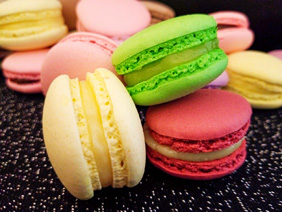
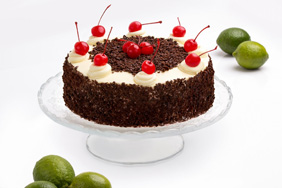
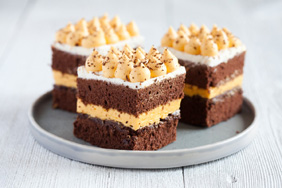
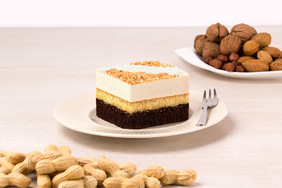
You may also prepare icings and glazes for pastries and cakes using confectionery fillings, especially the cream ones.
Gel icings
You may easily prepare fruit gel icings using the confectionery fillings with fruit pieces. Combine the filling with water in a 3:1 ratio and mix with warmed up gelatine and powdered sugar. Gel icings are used to cover pastries, e.g. marshmallows, to spread over the sponges or the layers in cakes.
Ganaches
Fruit confectionery fillings may be also used as an addition in preparing ganaches, especially to give them a characteristic flavor note. Ganache is a type of chocolate glaze with the addition of whipping cream. It is created with heated whipping cream and chopped chocolate, and optionally, butter. The glaze is shiny and glossy.
For example, a chocolate-orange ganache is made with dark chocolate, whipping cream and orange-flavored confectionery filling (5:3:1 ratio). A glaze to cover the cakes is made by mixing boiled cream with melted chocolate combined with some gelatine and the orange-flavored filling. By blending these ingredients until smooth you make a ganache to glaze cakes, e.g. gingerbread. You may also prepare light creams using a ganache. You whip the chilled chocolate and cream mixture until fluffy.
Glazes
To prepare a flavored glaze using Lauretta filling, e.g. vanilla, combine it with neutral mirror glaze in a 4:1 ratio. Mirror glaze (sometimes also called a cold decorative gel) spread over a product creates a transparent layer, protecting the product from drying out. Made by combining the filling and the mirror glaze, it does not fully set, it is still amenable to pressure.
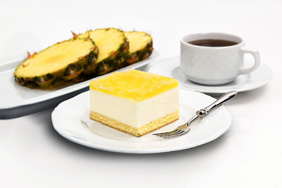
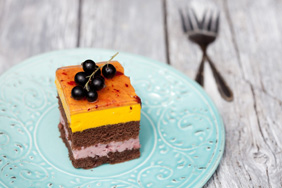
Cream and fruit confectionery fillings can be mixed with ingredients intended for baking.
To prepare an orange-flavored cheesecake you can use orange filling, semiskimmed cottage cheese and sweetened condensed milk. You mix the ingredients in a 1:4:2 ratio. You can also prepare an advocaat cheesecake by using Lauretta egg liqueur-flavored filling, combined with water and spirit in a 3:2:1 ratio.
Lemon tartelets are made using smooth lemon filling, butter, caster sugar and milk mixed in a 2:1:2:1 ratio.
You may use the filling in cheesecakes to stabilize them and as a flavoring component.
You can also use the fillings with cakes made using a cake mix. The exact method of use depends on the mix itself and the intended purpose, but as an example, you can add 10% of Lemon Twist cream filling to a batter made with a muffin mix to make lemon flavored muffins.
Example recipes:
- Easter Lemon Twist Muffins
- Blackcurrant and Coffee Cake with Coconut Layer
- Pineapple Pie Paradise Beach
- Orange Cheesecake with Condensed Milk
- Cheesecake with Egg Liqueur
- Corleone Italian Cake
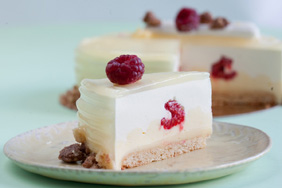
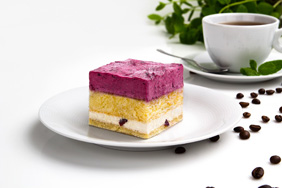
You may also use confectionery filling in chilled or frozen goods - ice cream and semifreddo.
Semifreddo – an Italian dessert resembling ice cream – is a frozen mix of cream or fruit mousse with whipped cream and an Italian meringue. You beat egg yolks with sugar to get kogel mogel. The egg whites are whipped to a froth and the cream is mixed with sugar and rum or brandy is added. The cream is combined with the kogel mogel and the whites. Crumbled meringues are added and the mixture is stirred again. The egg mixture and a variegato or raspberry filling are added into a dish interchangeably. The dessert is then frozen. Frozen semifreddo is decorated with meringues and fruit.
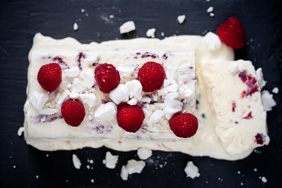
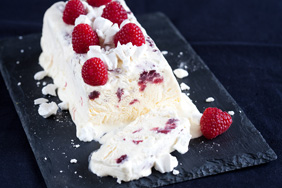
Confectionery fruit fillings may be used as a decorative element of cakes, pastries and other desserts.
The fillings can be used to decorate confectionery products because of their plastic texture and ease of application, as well as their variety of colors.
Example recipes
- Chocolate Cake with Coconut Cream (without Flour)
- Blackcurrant Zabaglione Cake
- Nut Ice Cream with Bananas and Vanilla Cream
- Chocolate-Vanilla Ice Cream with a Sour Cherry Filling
- Coconut Panna Cotta with Pineapple
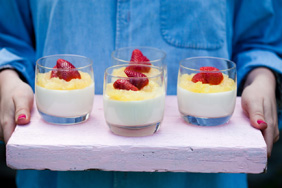
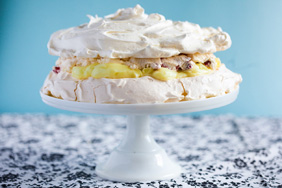
Cream confectionery fillings can be used as a flavoring and binding component.
You may also use Lauretta cream filling while making cake pops, cakesicles and truffles. They will give the products the expected taste and, at the same time, together with e.g. mascarpone cheese, they act as a binding element. To obtain stable pastries with the desired taste, mix sponge cake with Lauretta cream filling (e.g. champagne-flavored) and mascarpone cheese in a ratio of 5:2.3:1.3.
Example recipes:
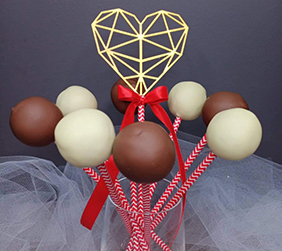
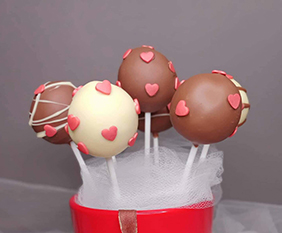
Bibliography
- Aleksandra Szydłowska, Danuta Kołożyn-Krajewska. Projektowanie innowacyjnych wyrobów z ciasta drożdżowego bez dodatku cukru. Innowacyjne Rozwiązania W Technologii Żywności i Żywieniu Człowieka 2016, 223, 273-284.
- Andrzej Gasik, Marta Mitek. Zastosowanie preparatów pektynowych. Przegląd Piekarski i Cukierniczy 2013, 3, 18-21.
- Ewa Gondek, Ewa Jakubczyk, Bogumił Jażdzyk Wpływ dodatku błonnika na właściwości sorpcyjne owocowych nadzień cukierniczych. Zeszyty Problemowe Postępów Nauk Rolniczych 2013, 573, 23–33.
- Ewa Jakubczyk., Agata Marzec. Właściwości mechaniczne chrupkich/kruchych ciasteczek. Inżynieria Rolnicza 2006, 3:31-36.
- www.kandy.pl
- Irena Kłoczko, Hanna Jędrzejczyk: Wyroby cukiernicze. [w:] Franciszek Świderski, Bożena Waszkiewicz-Robak: Towaroznawstwo żywności przetworzonej z elementami technologii. Wydawnictwo SGGW, Warszawa 2010.
- Iwona Sitkiewicz, Zbigniew Pałacha. ffect of aeration mode and storage on ed physical properties of agar based confectionery filling with chocolate coating. Acta Agrophysica 2006, 7(1), 219-230.
- Joanna Cichowska, Hanna Kowalska, Kinga Czajkowska, Maria Hankus. Wykorzystanie potencjału odwadniania osmotycznego i prozdrowotnych właściwości owoców w kreowaniu nowych produktów spożywczych. Postępy Techniki Przetwórstwa Spożywczego 2016, 2, 103-107.
- Katarzyna Kocierz. Technika w produkcji cukierniczej. Wydawnictwo WSiP-Rea. Warszawa, 2015.
- Katarzyna Kozłowicz, Franciszek Kluza. Wpływ wybranych dodatków prozdrowotnych na właściwości herbatników z mrożonego ciasta. Acta Agrophysica 2009, 13(1), 155-163
- Magdalena Kaźmierczak . Technologie produkcji cukierniczej. Wyroby cukiernicze. Tom 2. Wydawnictwo Wydawnictwa Szkolne i Pedagogiczne, Warszawa, 2014.
- Magdalena Woźniczko, Dominik Orłowski. Pierniki jako element potencjału turystyki kulinarnej Torunia. Zeszyty Naukowe Uczelni Vistula 2018, 60 (3): 91-114.
Author: Dr inż. Dorota Czerwińska
Faculty of Human Nutrition
Institute of Human Nutrition Sciences
Warsaw University of Life Sciences
Editing and proofreading: Ewa Socik i Dariusz Socik
COPYRIGHT NOTICE
All rights reserved.
All contents published in this article are under legal protection of the
regulation stated in Copyright and Related Rights Act of 4th of February
1994 (consolidated text published in Journal of Acts of 2018, item 1191).
Without author’s permission it is forbidden to replicate, copy, reprint, keep
or recycle them, using electronic devices or means, both in whole or in part.
It is also forbidden to further diffuse or disseminate contents due to the
Article 25 (1) Point (1) Letter (b) of Copyright and Related Rights Act
of 4th of February 1994.





